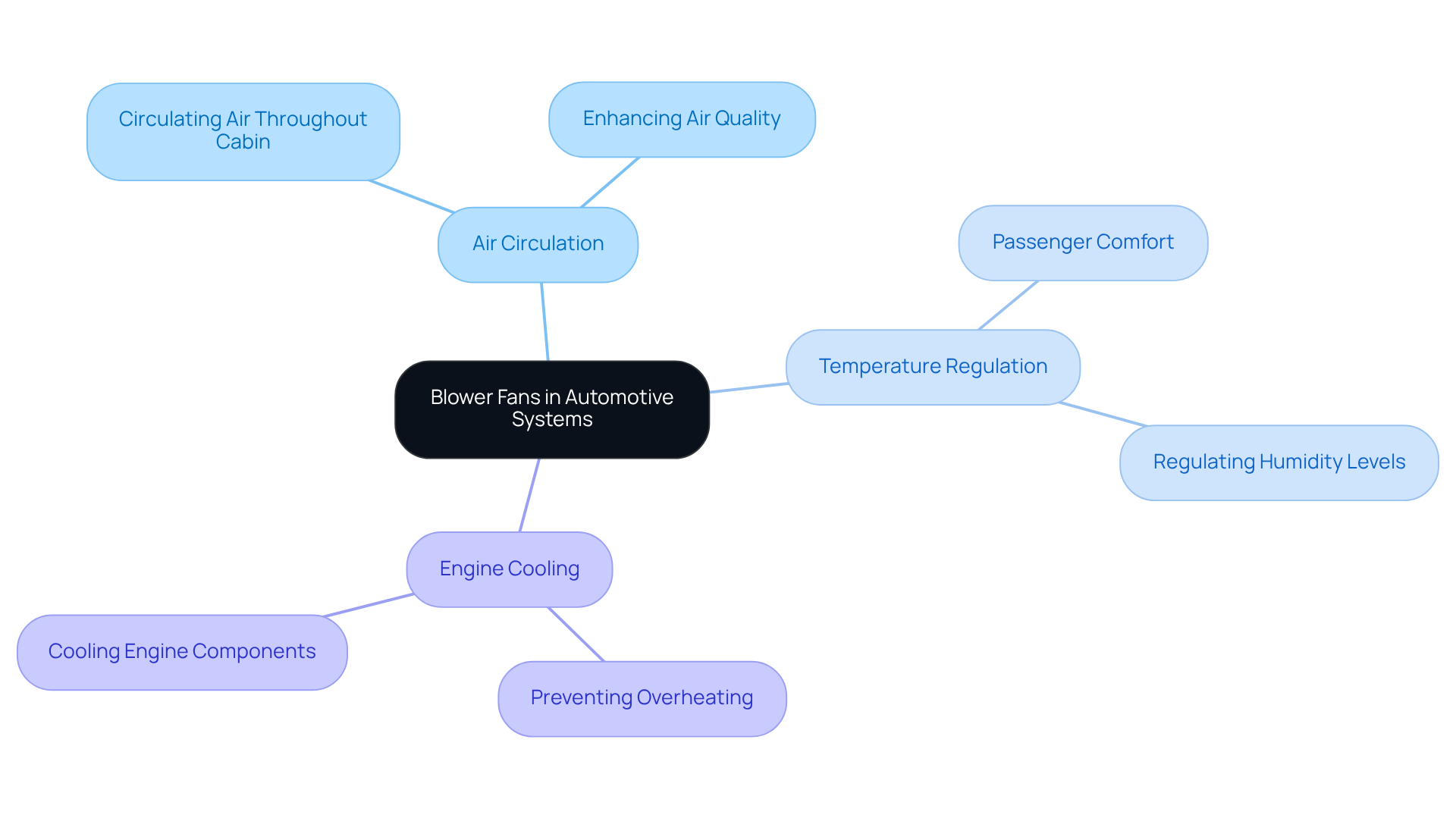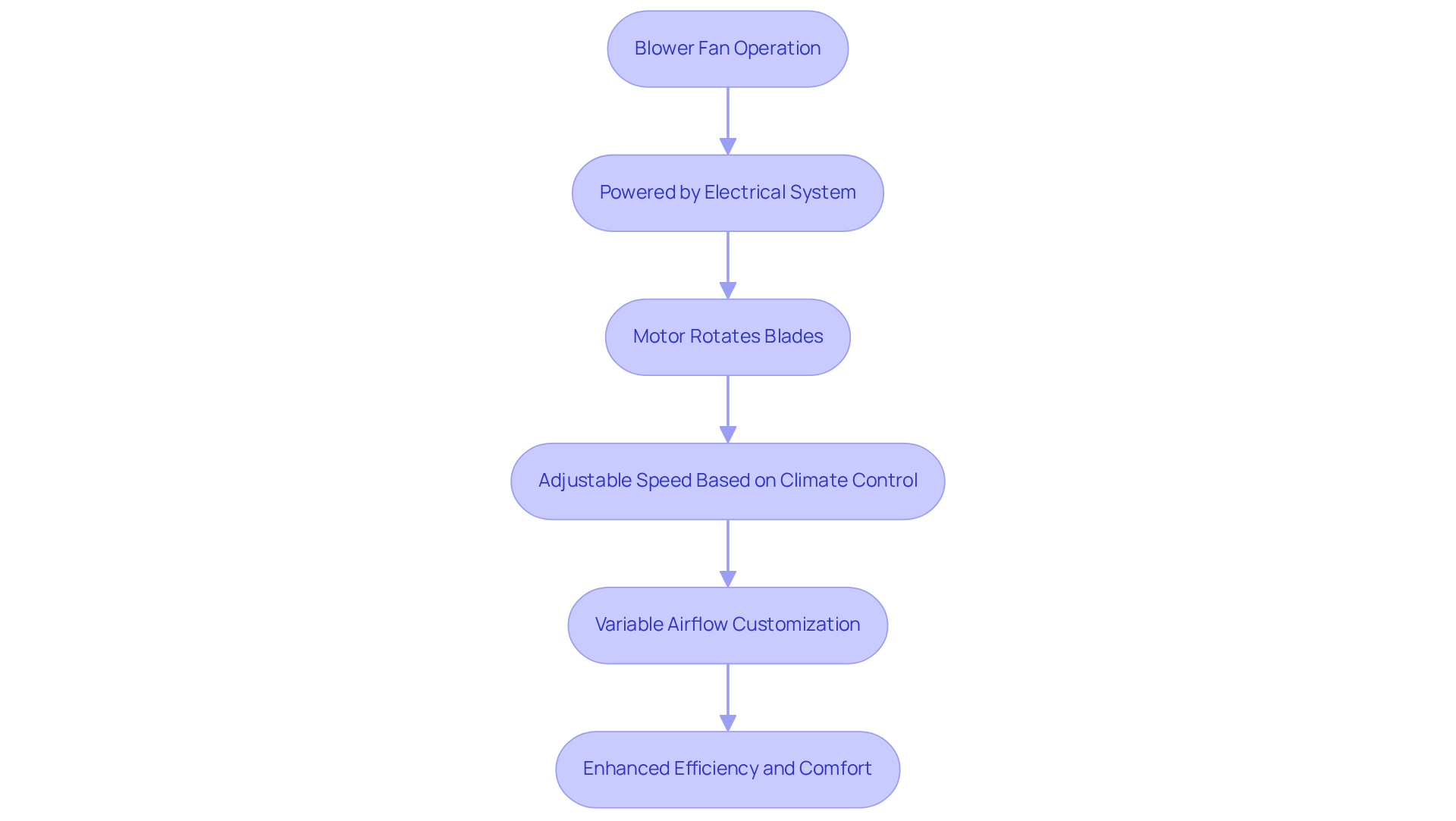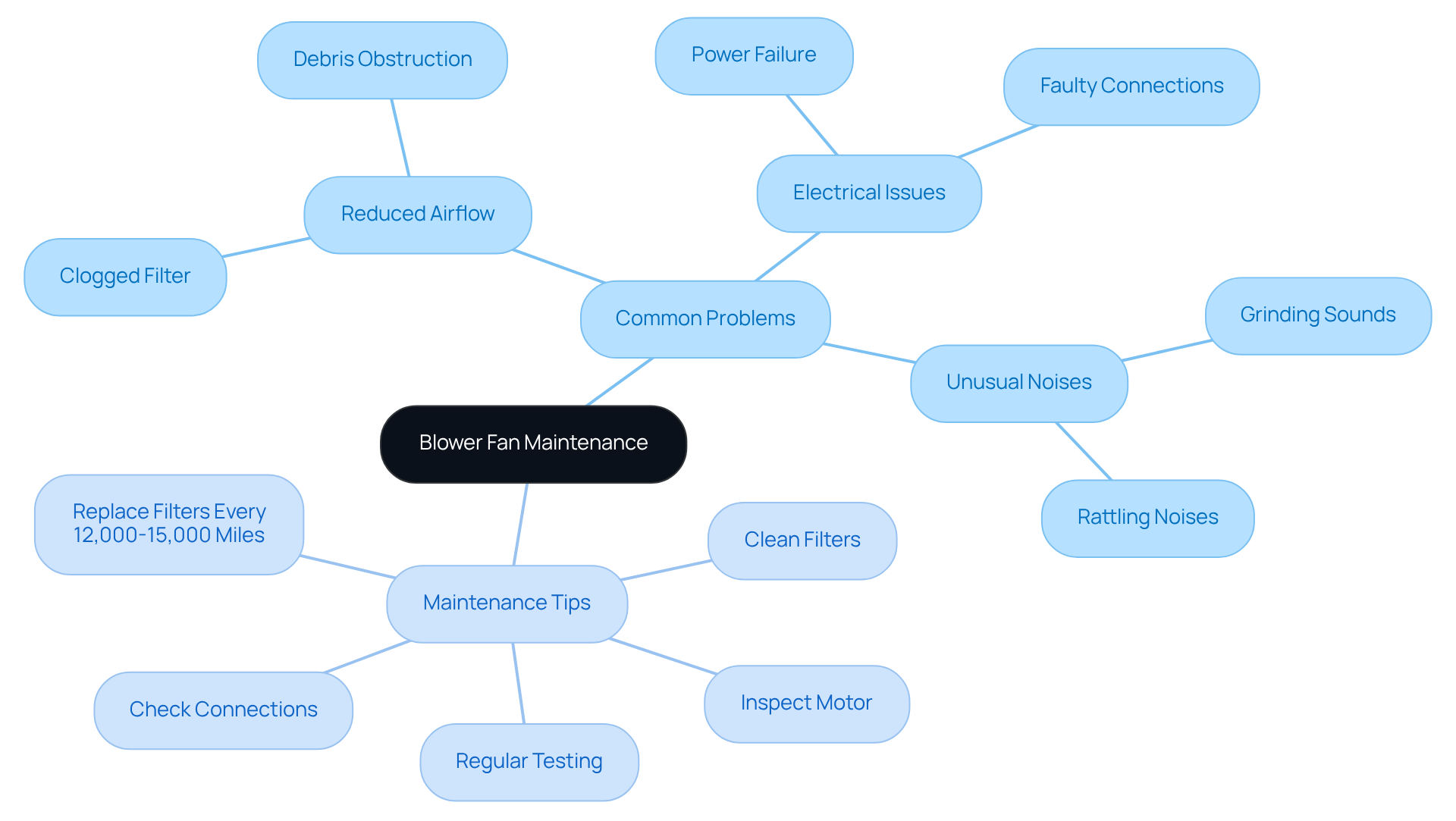Overview
The article addresses the operation, selection, and maintenance of master blower fans for cars, highlighting their essential role in ensuring passenger comfort and optimizing vehicle performance. It asserts that a thorough understanding of operational principles and key selection factors—including airflow rate, voltage rating, and durability—is crucial for effective maintenance and troubleshooting. This knowledge ultimately enhances the efficiency and longevity of the automotive HVAC system, providing actionable insights for professionals in the field.
Introduction
Understanding the intricate role of blower fans in automotive systems reveals their critical importance in ensuring passenger comfort and optimal engine performance. These unsung heroes of vehicle climate control not only circulate air but also help prevent overheating, making their selection and maintenance paramount for any vehicle owner.
However, with a myriad of options available and common operational challenges that can arise, how can one ensure they choose the right blower fan and keep it functioning smoothly? This article delves into the operation, selection criteria, and maintenance best practices for master blower fans, equipping readers with the knowledge to enhance their automotive experience.
Define Blower Fans and Their Role in Automotive Systems
The blower fan for car systems is an essential component, primarily responsible for circulating air throughout the cabin and facilitating engine cooling. They play a pivotal role in ensuring a comfortable environment for passengers by effectively regulating temperature and humidity levels. Furthermore, blower units contribute to the cooling of various engine components, which is crucial for optimal performance and the prevention of overheating. Recognizing the significance of their function is imperative when selecting the appropriate fan, thereby guaranteeing efficient operation in automotive applications.

Explain How Blower Fans Operate in Vehicles
The blower fan for car is a critical component in automotive climate control, responsible for drawing air through the ventilation system and directing it into the cabin or over engine parts. Powered by the vehicle’s electrical system, these fans utilize a motor to rotate the blades, with speed adjustments made according to the climate control settings. This capability allows for variable airflow that can be customized to the driver’s preferences. Advanced features, such as variable speed control and automatic temperature regulation, significantly enhance both efficiency and comfort.
The automotive HVAC fan motor market is projected to experience substantial growth, reaching USD 4.8 billion by 2033, driven by the increasing demand for efficient fan motors in electric transportation. The U.S. Department of Energy indicates that HVAC systems can consume up to 40% of the total energy in an electric vehicle, underscoring the importance of efficient fan motors.
Grasping these operational principles is crucial for effective troubleshooting and maintenance, as common issues often stem from electrical faults or mechanical wear. Automotive engineers emphasize that a well-functioning fan not only improves passenger comfort but also contributes to overall vehicle performance. Thus, it is imperative for engineers to prioritize routine inspections and maintenance.

Identify Key Factors for Selecting the Right Blower Fan
Selecting the appropriate blower fan for car applications requires careful consideration of several essential factors that directly impact vehicle performance and passenger comfort.
-
Airflow Rate: Quantified in cubic feet per minute (CFM), airflow rate is crucial for effective climate control within the vehicle. Higher airflow rates ensure that the cabin is adequately ventilated and comfortable, particularly in extreme weather conditions. Gagner-Toomey offers a broad product line of DC input Tube Axial devices optimized for performance and efficiency, catering to various airflow requirements.
-
Voltage Rating: Compatibility with the vehicle’s electrical system is essential, as most blower units operate at a standard voltage of 12V. Ensuring this compatibility is vital to prevent potential electrical issues, thereby enhancing overall performance.
-
Noise Level: The operational noise of the fan significantly influences passenger comfort. Opting for quieter devices that function below 65 dB contributes to a more enjoyable driving experience. Gagner-Toomey’s fans are engineered with low noise levels in mind, making them suitable for vehicle applications.
-
Size and Fit: The physical dimensions of the blower fan must align with the designated installation space in the vehicle. A proper fit is essential to avoid installation complications and ensure optimal airflow. Gagner-Toomey provides a comprehensive collection of DC input Centrifugal Blowers, with dimensions ranging from 15 to 225mm, ensuring compatibility for various vehicle designs.
-
Durability and Material: Fans constructed from premium, corrosion-resistant materials are crucial for withstanding the vehicle environment, which involves exposure to temperature variations, humidity, and vibrations. This durability is essential for longevity, with many automotive fan motors designed to exceed a mean time between failures (MTBF) of 30,000 hours.
By thoroughly assessing these factors, engineers can select a blower fan that not only meets specific operational requirements but also enhances overall performance and passenger comfort. Furthermore, Gagner-Toomey’s innovative cooling solutions, featuring integrated custom cooling options, position them as a leader in addressing the evolving demands for advanced cooling systems in commercial transport.

Discuss Common Problems and Maintenance Tips for Blower Fans
Blower fans can encounter several common problems that warrant attention:
-
Reduced Airflow: A clogged filter or debris obstructing the fan may lead to this issue. Regularly check and clean the air intake, and replace filters as needed. It is crucial to recognize that a car fan typically lasts 8-10 years; neglecting maintenance can result in reduced airflow, significantly impacting climate control and overall comfort within the vehicle.
-
Unusual Noises: Grinding or rattling sounds may indicate a failing motor or loose components. Inspect the fan for wear and secure any loose parts. Ignoring these sounds can lead to further damage and costly repairs, as they may signal hidden motor problems.
-
Electrical Issues: If the fan fails to operate, examine the electrical connections and fuses. Ensure that the fan is receiving power from the vehicle’s electrical system.
Maintenance Tips:
- Regularly clean the blower fan and surrounding areas to prevent dust buildup, which can lead to overheating and burnout. This includes maintaining the cabin air filter, which should be replaced every 12,000-15,000 miles to ensure optimal airflow and performance.
- Inspect electrical connections for corrosion or damage, as these factors can impede performance and lead to failures.
- Periodically test the fan’s operation to ensure it functions correctly. Address any issues promptly to avoid costly repairs.
- Be aware that fan issues can also affect fuel efficiency, making regular maintenance essential not only for comfort but also for cost-effectiveness.
By adhering to these maintenance tips and recognizing common problems, users can ensure their blower fan for car operates efficiently and effectively, ultimately enhancing the comfort and safety of their vehicles.

Conclusion
Mastering the intricacies of blower fans in automotive systems is essential for enhancing vehicle performance and ensuring passenger comfort. These integral components not only regulate cabin temperature and humidity but also play a vital role in cooling engine parts, thereby safeguarding against overheating. Understanding their operation, selection criteria, and maintenance practices is crucial for anyone looking to optimize their vehicle’s climate control system.
Throughout this article, we have discussed key insights, including:
- The operational principles of blower fans
- Factors to consider when selecting the right fan
- Common maintenance tips
Emphasis was placed on aspects such as airflow rate, voltage compatibility, noise levels, and durability, all of which significantly influence the effectiveness of blower fans in various automotive applications. Furthermore, recognizing and addressing common issues like reduced airflow and electrical faults can prolong the lifespan of these components and enhance overall vehicle efficiency.
Ultimately, the significance of blower fans extends beyond mere comfort; they are pivotal in achieving optimal vehicle performance and energy efficiency. Regular maintenance and informed selection not only improve the driving experience but also contribute to long-term cost savings. Prioritizing these factors will ensure that vehicles operate at their best, providing a safe and enjoyable journey for all passengers.
Frequently Asked Questions
What is the primary function of blower fans in automotive systems?
The primary function of blower fans in automotive systems is to circulate air throughout the cabin and facilitate engine cooling.
How do blower fans contribute to passenger comfort?
Blower fans contribute to passenger comfort by effectively regulating temperature and humidity levels within the vehicle’s cabin.
In what way do blower fans assist with engine performance?
Blower fans assist with engine performance by cooling various engine components, which is crucial for preventing overheating and ensuring optimal performance.
Why is it important to recognize the significance of blower fans when selecting one for a vehicle?
It is important to recognize the significance of blower fans when selecting one for a vehicle to ensure efficient operation in automotive applications.

